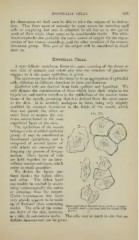Page 525 - My FlipBook
P. 525
EPITHELIAL CELLS. 535
for observation we shall soon be able to solve the enigma of its deriva-
tion. That there must of necessity be some means for renewing aged
cells or supplying lost ones is admitted by all, but as to the special
mode of their origin there seems to be considerable doubt. The white
blood-corpuscles are probably the main source of supply for the regen-
eration of lost tissues, osteoblasts, and the other members of the connec-
tive-tissue group. This part of the subject will be considered in detail
later on.
Epithelial Cells.
A very delicate membrane forms the outer covering of the derma or
true skin of animals, and enters also into the structure of glandular
organs; to it the name epithelium is given.
The microscope has shown this tissue to be an aggregation of epithelial
cells, differing in different situations in form and function.
Epithelial cells are derived from both epiblast and hypoblast. We
will dismiss the consideration of those which have their origin in the
hypoblast, and confine ourselves to the epithelium of the mucous mem-
brane of the mouth, premising that it is derived from the same source
as the skin. It is certainly analogous in foi'm, being only slightly
modified by constant immersion in the fluids of the mouth, which
does not permit the oldest or
Fig. 272.
outer layer to assume the cor-
neous nature found in the most
superficial layer of the skin.
The epithelium of the mouth
belongs to the stratified epithelial
group: it may be considered as
transitional epithelium, and is
composed of several layers of
cells which are constantly un-
dergoing the process of desqua-
mation. These layers of cells
are held together by an inter-
cellular cement-substance, which
exists in small quantities.
We divide the layers into
three kinds : the infant, older,
and oldest. The oldest layer
can readily be studied by exam-
ining microscopically the saliva
or scrapings from the tongue.
Under examination this layer
very plainly appears to be made
up of flattened discs containing
EpiUielial Cells in the Oral Cavity of ISIan : a, large;
nuclei. The cells of the corne- 6, middle-sized ; c, the same with two nuclei (high
power).
ous layer of the skin, however,
as a rule, do not contain nuclei. The cells vary so much in size that no
definite measurement can be given.


